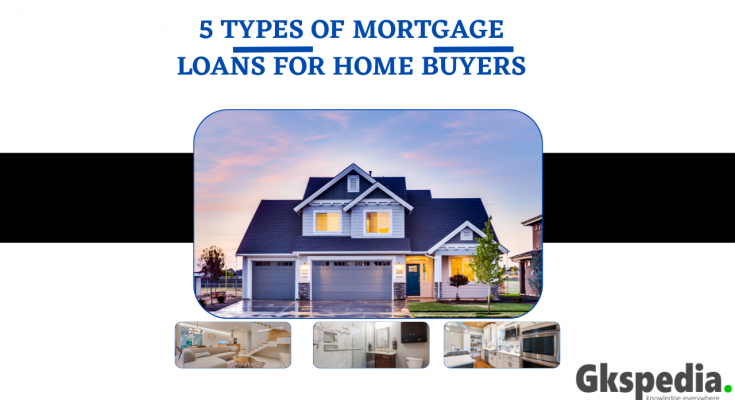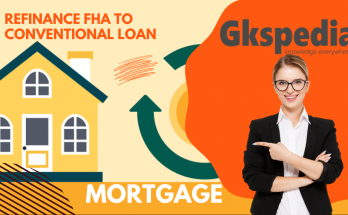Introduction: When embarking on the journey to homeownership, first-time buyers often find themselves navigating a complex landscape of financial options. Among these, mortgage loans stand out as a pivotal means to make the dream of owning a home a reality. In this comprehensive guide, we will delve into the various types of mortgage loans tailored specifically for first-time buyers. Whether you’re a novice in the real estate market or seeking to expand your knowledge, understanding the nuances of “Mortgage Loans for First-Time Buyers” is the first step towards securing your future home. Join us as we unravel the diverse array of mortgage loan options designed to suit your unique needs and financial aspirations.
As a prospective homebuyer, educating yourself about mortgage types is just as important as learning about the area you plan to live in. Applying for a mortgage can be complicated, and what type of housing Determining early whether a loan best suits your needs can help you orient yourself towards the type of home you can afford.
There are several options for loans when buying a home. Therefore, it is important to fully understand the pros and cons of each type before making a decision. Depending on the type of mortgage you choose, there are different requirements that affect interest rates, loan terms, and lenders. Choosing the right home loan for your situation can reduce your down payment and reduce your total interest payments over the life of the loan.
What Is a Mortgage?
Mortgage payments have two components: principal and interest. The principal is the amount borrowed. Interest is an additional amount (calculated as a percentage of the principal) that a lender charges for the privilege of borrowing money that can be repaid over time. During the term of the mortgage, you make monthly installments based on the amortization schedule set by the lender.
The collateral for a mortgage is the house itself, so if the borrower misses their monthly payments and defaults on their loan, the lender can sell the house and get their money back.
Mortgage loans are typically long-term debts of 30, 20, or 15 years. During this period (also called the loan’s “period”), you repay both the amount you borrowed and the interest on the loan. Mortgages are repaid regularly. Repayments are usually made in the form of monthly payments of principal and interest.
According to Robert Kirkland, vice president, divisional community, and manager of affordable credit at JPMorgan Chase & Co., “a component of each monthly mortgage payment goes toward reducing the principal or outstanding mortgage debt, and a piece goes toward repaying the mortgage balance.” It will be used to pay the loan’s interest, he said. More principal repayments will be made over time.
If you default on your mortgage, the lender can get your property back through the foreclosure process.
“Until the mortgage is paid in full, you technically don’t own the property,” said Bill Packer, executive vice president and COO of American Financial Resources in Parsippany, New Jersey. “Usually when you close the accounts, you also sign a promissory note, which is your personal obligation to repay the loan.”
Conventional Loan
Traditional credit is what most people think of as a mortgage loan. This type of loan is not guaranteed by the government, so your home usually serves as collateral in case you are unable to repay the loan.
With conventional loans, he has two options: compliant and non-compliant. The differences between them are very important, so read carefully before proceeding with a traditional loan. The most important thing to know about them is that compliant loans meet all her FHFA requirements, but non-compliant loans do not. Traditional loans can be used to purchase a primary home, secondary home, or investment property, and you may be able to pay as little as a 3% down payment through Fannie Mae or Freddie Mac. Once your equity reaches 20% of his, you can even ask your lender to cancel your personal mortgage insurance to save you future monthly payments.
Unfortunately, to qualify for traditional credit, you need a minimum credit score of 620, even if you’re refinancing. The Debt to Income Ratio (DTI) must also be less than 43% for him and if the down payment is less than 20% of his, he must pay a PMI.
Pros of conventional loans
- can be applied to a primary residence, a second residence, or an investment property.
- Even though interest rates are slightly higher, overall borrowing expenses are often lower than those of other mortgages.
- When you achieve a 20% equity position, you can ask your lender to eliminate private mortgage insurance (PMI) or refinance.
- In loans supported by Freddie Mac or Fannie Mae, you can put down as little as 3% of the purchase price.
- The cost of closing may be covered by the seller.
Cons of conventional loans
- Many times, a FICO score of 620 or greater is necessary (the same applies for refinancing)
- greater deposit required than for some government loans
- having a debt-to-income (DTI) ratio that is no more than 43% (50 percent in some instances)
- If your down payment is less than 20% of the sales price, you’ll probably have to pay PMI.
- Significant evidence of income, assets, down payment, and job is necessary.
Pros of jumbo loans
- Many times, a FICO score of 620 or greater is necessary (the same applies for refinancing)
- greater deposit required than for some government loans
- having a debt-to-income (DTI) ratio that is no more than 43% (50 percent in some instances)
- If your down payment is less than 20% of the sales price, you’ll probably have to pay PMI.
- Significant evidence of income, assets, down payment, and the job is necessary.
Who should get a conventional loan?
A traditional mortgage is generally your best option if you have good credit and the money to put down a substantial amount of money. The most common option for homebuyers is a conventional mortgage with a 30-year fixed rate.
Government-Backed Loan
There are different types of government-sponsored loans that different people can qualify for. If you qualify, these mortgages are a great way to find loans with low or no down payment and avoid paying PMI or MIP.
Here are some of the government-sponsored mortgages.
FHA Loan
FHA loans are backed by the Federal Housing Association and require only a 3.5% down payment. If you meet the eligibility requirements, this type of loan is perfect for someone with a low credit score or someone who can’t afford his traditional 20% down payment but wants a reliable and secure loan.
VA Loan
Veterans Affairs Loans are backed by the Veterans Administration and are available to veterans and active duty military. If you or your partner qualifies for a VA loan, it’s almost always a good idea to get one.
VA loans have no down payment requirements, no PMI or MIP required, and no minimum credit requirements. There is a funding fee, which can usually be paid together with the cost of the loan or closing costs and is usually capped.
USDA Loan
USDA loans may be available for real estate located in rural or other USDA-eligible areas. There are specific income requirements, but some borrowers may be exempt from the down payment. USDA loans have additional fees and require mortgage insurance, but they are a great way to buy rural property.
Pros of government-insured loans
- When you are unable to obtain a traditional loan, assist you in financing a property.
- fewer restrictions on credit
- not require a sizable down payment
- available to both first-time and return customers
- Mortgage insurance and down payment are not necessary for VA loans.
Cons of government-insured loans
- FHA loans must pay mandatory mortgage insurance premiums, which cannot be waived absent a refinancing into a conventional loan.
- FHA loan restrictions are often lower than conventional mortgage loan limits, which reduces the possible pool of available options.
- The borrower must reside in the property (although you may be able to finance a multi-unit building and rent out other units)
- Depending on the kind of loan, prepare to present additional papers to demonstrate eligibility.
Who should get a government-insured loan?
Are you experiencing problems being approved for a traditional loan because you have poor credit or little money set up for a down payment? Loans sponsored by the USDA and the FHA can be a good choice. Veterans Affairs-backed loans are frequently preferable to traditional loans for active-duty military personnel, veterans, and qualifying spouses.
Fixed-Rate Loan
Fixed-rate loans come in two options: 15 or 30 years. The idea behind fixed-rate loans remains the same regardless of whether the loan term is long or short.
For the duration of the loan, the interest rate is set. You don’t have to worry about variable interest costs and your monthly payments will always stay the same, but you’ll usually end up paying a higher interest rate than a variable rate loan, which ends up paying you a significant amount. I’m a little curious.
Pros of a fixed-rate loan
- For the length of the loan, the monthly principal and interest payments are fixed.
- Housing costs are easier to plan from month to month.
Cons of a fixed-rate loan
- You’ll need to refinance if interest rates drop to take advantage of the reduced rate.
- Interest rates on fixed-rate mortgages are often higher (ARMs)
Who should get a fixed-rate loan
A fixed-rate mortgage is the best option for you if you want to live in your house for at least five to seven years and want to prevent the possibility of modifications to your monthly payments.
Adjustable-Rate Loan
Unlike fixed-rate loans, variable-rate loans change interest rates during the term of the loan. This means that your monthly payment will increase for a period of time and then decrease again. Over time, you may pay less interest, but fluctuating monthly costs can make the loan unaffordable and cause the loan to default.
Pros of an Adjustable-rate loan
- Lower fixed rate for the first couple of years of homeownership (although this isn’t a guarantee; recently, 30-year fixed rates have actually been keeping up with 5/1 ARMs); may greatly lower the cost of interest payments
Cons of an Adjustable-rate loan
- Mortgage payments can become unaffordable, which would lead to a loan default.
- In a few years, home prices can decline, making it more difficult to refinance or sell before the loan resets.
Who should get an Adjustable-rate loan
An ARM might help you save on interest payments if you don’t intend to live in your house for more than a few years. But if you’re still living in the house, you need to be prepared for a certain amount of risk that your payments can go up.
Jumbo Loan
Jumbo loans are common in areas with very high-interest rates, such as Los Angeles, New York, and Hawaii. You don’t meet the FHFA requirements because you’re over the limits set, but you can buy a more expensive property if you want.
Jumbo loans typically require you to make a 10-20% down payment, have a credit score of at least 700 or above, have a DTI below 45%, and provide a significant amount of assets in the form of cash. Or a savings account.
Jumbo loans are good for buying expensive homes, but they require good credit and various documents to be approved. It’s not suitable for all home sales, but it’s useful for people who live in expensive metropolitan areas and want to buy a home.
Pros of jumbo loans
- can take out additional loans to buy a more costly house.
- Interest rates for jumbo loans tend to be competitive with other conventional loans
- For some borrowers, this may be the only route to purchase in locations with sky-high housing values.
Cons of jumbo loans
- In many circumstances, a down payment of at least 10% to 20% is necessary.
- A FICO score of 700 or above is often required.
- must have a DTI ratio greater than 45%
- You must demonstrate that you have sizable cash or savings assets.
- Typically, more thorough paperwork is needed to qualify
Who should get a jumbo loan?
A jumbo loan is probably your best option if you want to finance a property whose selling price is more than the most recent conforming loan restrictions.
Other types of home loans
In addition to these common types of mortgages, there are other types that you can find when looking for a loan.
Construction Loans – If you want to build your own home, a construction loan is for you. You can choose to get another construction loan for your project and another mortgage to pay off. A home savings loan that combines construction costs and financing into one loan product is also an option. Both variants typically require a higher down payment and proof that you can afford to pay monthly installments.
Interest Only Mortgage – In an interest-only mortgage, the borrower makes interest-only payments for a period of time (usually he is 5-7 years), followed by principal and interest payments. You can’t build an asset right away with interest on it, as it initially pays interest only for a specific period of time. A home loan only. Still, these loans are best suited for those who know they can sell or refinance, or who can reasonably expect to be able to afford higher monthly payments in the future.
Piggyback Loans – Piggyback loans, also known as 80/10/10 loans, are actually two loans. One at 80 percent of the house price and another at 10 percent. Pay the remaining 10% deposit. These loan products are designed to help borrowers avoid mortgage insurance payments. Eliminating these PMI payments may sound tempting, but remember that a piggyback loan requires two closing costs and accrues interest on two loans. Do the math and see if you’re really saving enough money to justify this unconventional deal.
Balloon Mortgage – Another type of mortgage is a balloon mortgage, which requires a large payment at the end of the loan term. We typically pay based on a 30-year term, but only for a short period of time. B. 7 years. At the end of the loan term, make a large payment on the outstanding balance. This can get out of hand if you’re not prepared or your credit situation deteriorates. You can use Bankrate’s Balloon Mortgage Calculator to see if this type of loan is right for you.
Find Your Perfect Mortgage Loan
Every lender and loan is different, so take your time looking around. With enough research and professional help, you can find the perfect mortgage for your new home in no time. However, while looking, remember to stick to a pre-determined budget and seek credit only through approved lenders to avoid fraud and exorbitant fees.




